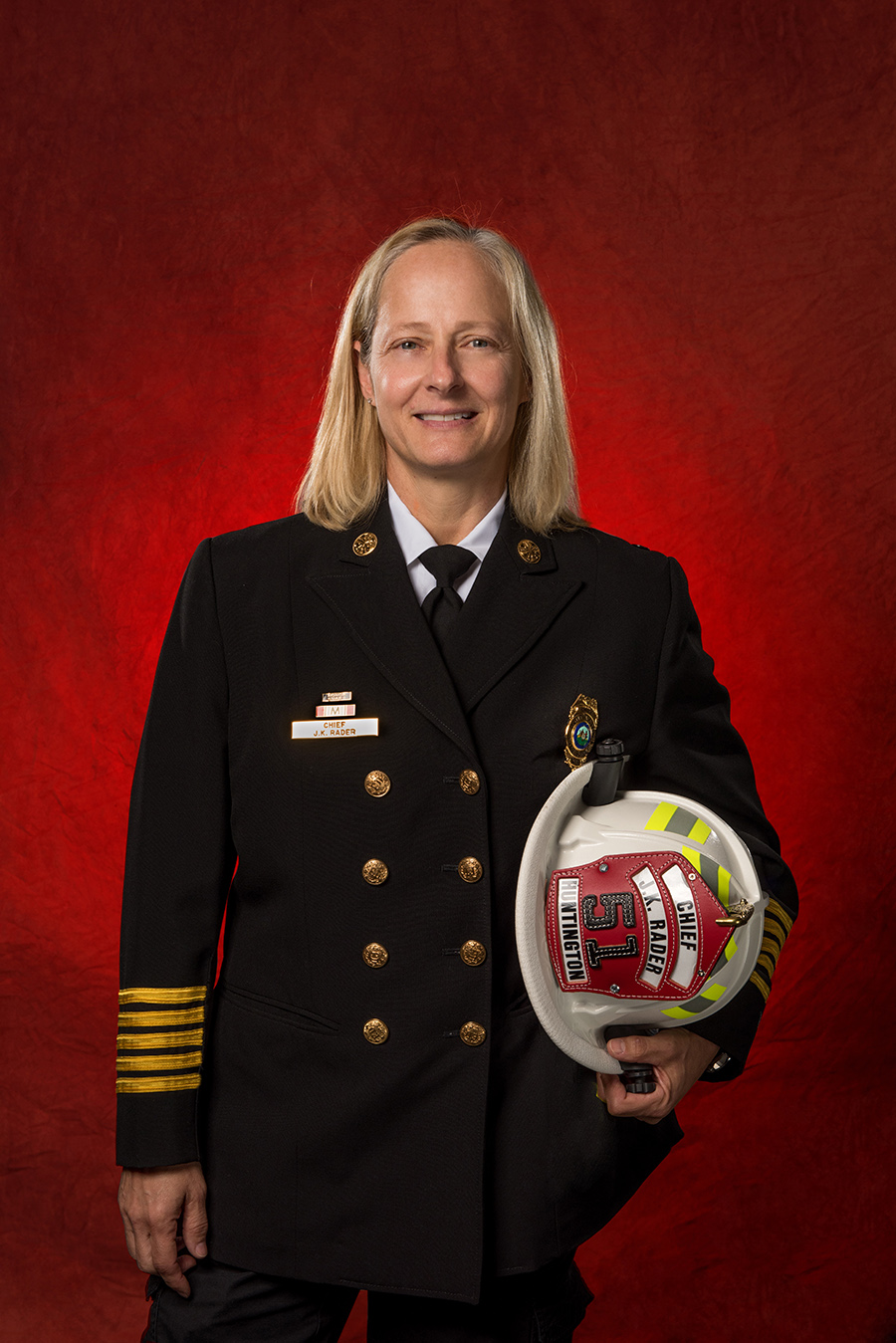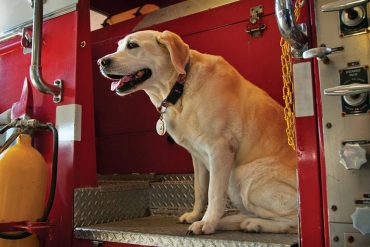The first female fire chief in West Virginia is impacting our community in big ways.
By Jean Hardiman
HQ 99 | AUTUMN 2017
Jan Rader was recently sitting at a Mission Tri-State prayer breakfast, where pastors gather monthly with city leaders to pray. As chief of the Huntington Fire Department, she was sitting with the police chief and others who have been working diligently to serve and protect throughout the city’s plight of drug addiction.
They have an exhausting, often heart-wrenching job. Some lives are lost to overdose. Many lives are saved, but not reformed. There is relapse. There is hopelessness.
“The negativity can get you down,” said Rader, who joined the Huntington Fire Department in 1994 and became the first female professional fire chief in West Virginia history this year.
But hopelessness isn’t her style, and in the midst of the prayer breakfast, she received a Facebook message that reinforced her indestructible, much admired optimism and spirit. It was from a man who wanted to thank her and her colleagues.
“I know this is random, but God put it in my heart to let you know the difference you’ve made in my life,” he wrote. “You in your time have saved my life from heroin overdose on four separate occasions. The last one was 3 1/2 years ago. I went to long-term treatment, completed it and decided to turn things around.”
He told her that he had gotten married, started a great career, had been raising his children and bought a home. His dreams were gradually coming true.
“None of this would have ever happened if it wasn’t for you all doing what you do so selflessly,” he wrote.
That is exactly the kind of news Rader loves to receive and seldom gets in a career that so often places her in a position to save a life, with little chance afterward to know what became of it.
It’s not the kind of daily work she was expecting to do as a firefighter. It was also unexpected for Rader to hold a position of prominence. She never foresaw herself as chief and she certainly never saw herself on a regional and national stage, personifying her city’s compassion and courage in its battle with addiction.
Most recently, she was featured in a Netflix documentary entitled “Heroin(e),” created by West Virginian Elaine Sheldon and also featuring Family Court Judge Patricia Keller of Cabell County, and Necia Freeman, a local real estate agent who started the Brown Bags Ministry — a ministry to provide food to area prostitutes, as well as assistance when sought.
Before she became chief, Rader also was asked by Mayor Steve Williams to serve with the Mayor’s Office of Drug Control Policy, which she did wholeheartedly, helping to establish the county’s first harm reduction program, which includes a clean needle-exchange for users, to prevent the spread of disease.
“She’s brilliant. That’s part of how powerful she is,” Williams said. “She combines intellect with passion, and those qualities give her a leg up to conquer anything that is in front of her.”
Patricia Keller, whom Rader said she has come to deeply respect, described Rader as a genuine asset to the community.
Despite her petite stature, “There is nothing small about her,” Keller said. “She is the most caring person I have ever met, and the most positive. I love positive mental energy, and she wreaks of that.”

Huntington Fire Chief Jan Rader rappels down the side of the 17-story West Virginia Building during “Over the Edge” on Friday, June 16, 2017, in downtown Huntington. The event is a fundraiser for United Way of the River Cities.
Becoming a heroine
Becoming a female firefighter was not a childhood dream for young Jan Rader, growing up in Ironton, Ohio. She is the youngest of three children to the late Robert Rader, who worked as maintenance director at Ohio University Southern, and Mary Kay Rader, now 82, who worked with the mentally disabled for over 30 years.
“I had a great upbringing,” Rader said. “My parents were both hardworking people who gave back to their communities.”
Her mother volunteered with the American Cancer Society, and her father and older brother helped start area chapters of Habitat for Humanity, even building houses with Jimmy Carter in Georgia each year, Rader said.
No one in her family or close circle fought fires or inspired her current career though, coincidentally, Ironton Fire Chief Mike Mahlmeister and Rader were both members of the Ironton High School Class of 1983.
Rader was more interested in rare stones back then.
“I was a big rock hound. I have a lot of rocks around my house. It’s kind of embarrassing,” Rader said, adding that some of her favorites are arrowheads she found in her grandfather’s garden as a child.
At 20, she attended the Gemological Institute of America in Santa Monica, California, and then became assistant manager at Towne Silver and Goldsmith, a family-owned jewelry store, in Washington, D.C.
“We had this little bay window where jewelers sat to make jewelry or repair jewelry, so you could watch it being repaired,” Rader said. “It was a really neat little store. I loved it.”
One day while working, she saw a woman turn blue and collapse in front of the store.
“I didn’t even know CPR or what to do, so I called 911,” Rader said.
When the fire department arrived, Rader noticed a woman with them. The woman’s life was saved, and Rader’s life was changed forever.
“Being a jeweler was cool. I liked being an artist and making jewelry, but I just didn’t feel like I was giving back,” Rader said. “Within a couple weeks, I took a CPR class because I remember feeling really helpless, and I didn’t want to feel helpless again.”
She also started asking some firefighters she jogged with about what it takes for a woman to become a firefighter.
“I mentioned this call to them, and they said, ‘We have a lot of women in this area who are firefighters. You could do it. You don’t have to be really big. You just have to be in really good shape,’” Rader said.
After her CPR class, she took a basic EMT class and then signed up to take the Fairfax County, Virginia, Fire Department test. Her brother, a Presbyterian minister who was in Huntington at the time, urged her to take the test in Huntington instead and come back to the Tri-State.
Of the hundreds who signed up to take the test on that occasion in 1993, Rader ended up No. 2 on the list and joined the Huntington Fire Department in 1994 at the age of 29. She was the third woman to serve — one had spent a year at the department several years earlier, and one was still there, Danielle Bauer.
“She had a back injury and ended up having to take full disability,” Rader said. “She’s awesome. A tough cookie.”
Rader has been the sole woman with the Huntington Fire Department ever since.

Jan Rader is sworn in as fire chief for the Huntington Fire Department by Municipal Court Judge Cheryl Henderson on Wednesday, April 12, 2017 in the Jean Carlo Stephenson Auditorium at City Hall in Huntington.
Overcoming obstacles
From the beginning, being female, and a petite one at that, had its advantages and disadvantages. The men in the department reacted to her differently.
“There were men who were very supportive. As long as you could do the job, they had no problem with you,” Rader said. “Then you had another group that was adamant that you don’t belong. That’s slowly changed over the years. It used to bother me that I stuck out like a sore thumb. But over the years, I’ve learned to embrace it.”
She learned all the ways of accomplishing things, minus the brute strength.
“In physical jobs, there is more than one way to skin a cat. You just figure that out ergonomically,” Rader said. “It’s certainly nice to have someone of small stature to get into small spaces. All shapes and sizes can be utilized to the advantage of the fire department. They don’t pick me to bust down a door, but when they needed somebody to go into that small attack space, or that very small crawl space underneath the house, they’d say, ‘Come here, Jan, you’ll fit.’”
As for the danger and devastation she’s encountered in a career of fighting fires, “I think you just do it and you fall apart later when you realize the magnitude of what you just did,” Rader said. “I think that’s pretty common.”
The downtown Emmons Building fire on 3rd Avenue, which took the lives of nine people in 2007, was among the worst in her time and profoundly affects many Huntington Firefighters to this day. She wasn’t working that night, but she remembers the aftermath, and helping Greg Fuller, the chief at the time, locate the last body inside.
“Whether they were there that night or helping over the next few days, I don’t know anybody who that fire does not still affect,” Rader said. “That was Jan. 13, 2007, at 11:02 p.m. Is it bad that I still know that?”
Through it all, Rader started climbing to higher ranks within the department. She became a captain in 2006, and then became deputy chief in 2015 under Chief Carl Eastham. She was named interim chief in December 2016 and permanent chief in March of 2017, making West Virginia history.
“It’s funny. There were dark days and tough times (early on), and all I thought was, ‘I’d like to make it 20 years and retire as a captain,’” Rader recalled. “I thought anything beyond that is icing on the cake. I never had a desire to be chief. But here I am.”
Along the way, Rader also became a paramedic and then studied at Ohio University Southern to become a registered nurse. She began working as an emergency room nurse on her days off from the fire department. It was in this capacity that Mayor Williams got the opportunity to see what a truly remarkable person Rader was. Williams said he remembers an occasion when his father, who has since passed away, was rushed to the emergency room, and his mother was extremely upset.
Rader came out to check on them.
“She was so helpful to my mom,” Williams said. “She got down on her knee and held her hand and sat eye-to-eye with her, and you could just see Mom calming down. Dad, too. I will always be grateful to how she helped my family.”
In the years that have followed, “Anything I’ve asked of her, she’s never said no,” Williams said. In her role with the Mayor’s Office of Drug Control Policy, she drove many of the strategic plans and demonstrated a remarkable ability to get people on board with her vision. Her passion spills into the room.
“Wherever she goes, people are drawn to her,” Williams said. “This diminutive lady defies every stereotype you have of a big, buff firefighter. I’d put her up against anybody, anywhere, anytime. She’s tougher than a pine knot, and her heart is bigger than the city.”
Teresa Ball, who works as Labor/Management Liaison for the city of Huntington, said she is proud to call Rader a friend and marvels at her strength and grace.
“The qualities I most admire in Jan are her confidence, can-do attitude and her kindness to all. Then there’s her passion for the work she does and her dedication to the fire department, the city and the mayor’s vision that everyone should be treated with dignity and respect,” Ball said. “But most of all, I admire the difference she makes in people’s lives every day as the fire chief, nurse, crusader and educator against addiction.”
Changing roles
Just as Rader’s position has changed, so has the role of the first responder, especially since 2011 when there was a crackdown on prescription painkillers, causing many of those addicted to turn to heroin – a far more dangerous drug.
“It started out slowly changing, and then it kind of snowballed,” Rader said. “I was probably on the job a good 10 years before I saw a significant number of deaths, and those were more times than not, older people at the end of life. But nowadays, you take any new firefighter here, and they’re seeing probably 40 or 50 deaths a year because of this epidemic.”
She said 26.7 percent of the time her firefighters get on a fire truck, they respond to an overdose. They fight fires only 7 to 8 percent of the time.
If she’s out and an overdose call comes in, she often goes along, just to be another pair of eyes on the scene.
“You can’t have enough eyes to watch the scene,” Rader said. “This is an unpredictable time, and sometimes it’s just to watch my guys’ backs, help out EMS if they need it, help out the police. There are so many calls daily now.”
Rader said there are an average of five overdose calls per day, and that number continues to rise every year.
“It’s exhausting mentally for the people on the front line,” Rader said. “As chief, I worry. Here’s the thing — firefighters and first responders in general are pretty tough. They don’t accept help from the outside. Providing them with help can be tricky. They don’t accept that well because they’re the ones who are the helpers.”
They’ve taken an oath to protect life and property and can become understandingly frustrated working with addicts, who won’t seek recovery and have difficulty turning their backs on the very thing that repeatedly tries to steal their lives.
Rader said she doesn’t know what the answer is, but she believes in reviving people as many times as it takes for them to seek long-term recovery and succeed.
“What’s wonderful about our community right now is they’re listening to people on the front lines,” Rader said. “We’re allowing doctors and people at Marshall to do ride-alongs with us and nurses at the health department to do ride-alongs with firefighters, so they can understand what it’s like helping them on the front lines.”
She believes the city’s harm-reduction program will prove to be extremely successful in preventing the spread of Hepatitis and other diseases.
“Mayor Williams is an amazing person in that he would step up to the plate and say, ‘I don’t want Huntington to be defined by the problem. Instead, I want Huntington to be known for how we fixed the problem.’ I think that is key,” Rader said. “I feel like Huntington is blessed because we’re a tight-knit community and we’re willing to help each other.”
She compares the community’s response to this tragedy to their response after the 1970 Marshall University plane crash.
“I was 5 when that plane crashed, and it was close to a farm that my grandpa owned at the time out on Dock’s Creek,” Rader said. “So I still remember seeing that vividly — the side of the hill. That united our community back then, and I think that same spirit is present today. I like to think it is, anyway.”
When Rader is not saving lives and inspiring others to keep fighting, she likes to hike and relax with her family and play with her two dogs, a rescued hound dog and a miniature golden doodle that is “so stinking cute, you can hardly stand it.” Rader has six nieces and nephews, including one nephew who is an Ironton firefighter. She recently took her mother ziplining at Hocking Hills for her 82nd birthday. “That is what she wanted to do,” Rader said.
She points to her parents as the source of her strong will.
“I’m just stubborn — you can’t give up,” Rader said. “My dad was stubborn. My mom is obviously a little stubborn. And giving back to your community was how I was raised. I’ve had the opportunity to talk to people around the country dealing with the same problems we are and they seem to have a lot of money, but not the collaboration that we do. We seem to be doing more with less, as a community. So I think that speaks volumes about who we are.”
As for being the first female professional fire chief in West Virginia, Rader said she mostly thinks of it as having a job to do, but she wants to embrace it in the sense of encouraging other girls to follow their dreams.
“I just hope young girls realize that no matter your size or your sex, you can do whatever you choose to do,” Rader said. “If there’s a barrier, there’s always a way around it or over it or under it.”
The Huntington area has so many strong women to look up to, Rader said, adding that Freeman and Keller, who are featured in the Netflix film with her, both inspire her greatly. Ball and Cathy Burns, who both work for the city, do as well.
Ball said she is inspired by Rader in return.
“She did not get to where she is today because the road was easy,” Ball said. “She got there because stuff went wrong and she handled it. She handled it in a thousand different ways on a thousand different days, but she handled it. Women young or old have an excellent role model in Jan. She has taught us that if we work hard and hold our head high, we, too, can be successful.”





